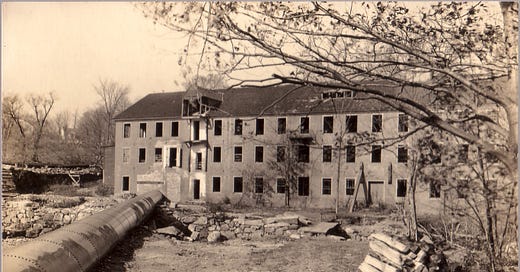April 5, 1915
The Columbian Manufacturing company has planned considerable work in this town as soon as the frost is out of the ground. A pen-stock will be run from No. 2 mill to No. 2 mill, High Bridge, having a diameter of five feet and nine inches, covering a distance of 2700 feet. The tall chimney of "Waterloom" mill, towards 100 feet high high, was taken down recently. An excavation was made on one side and wooden props placed in position; when all details were attended to, a fire was started under the wooden structure and the chimney fell in seven minutes. The "Waterloom" mill was erected in 1821, originally 84 feet long and 40 feet in width, consisting of three stories, each 10 feet high, and all in one room. Later it was enlarged. Sheeting was woven at first; later Jeans and flannels, and blue denim of 1 heavy quality which was a good seller in foreign markets. The Columbian Manufacturing company purchased the mill in 1855. In 1895 the structure was condemned, dismantled and the machinery removed. This is said to have been the second cotton milt erected in New England, the first cotton mill having been built in Slatersville, R. I., and the first in New Hampshire, where water power was used for running the looms. From this originated the name "Waterloom." James Wheaton Bliss, who became a citizen of this town in 1821, was a machinist and carpenter. He was the superintendent of the building of three cotton manufactories upon the Souhegan river, the "Waterloom." the Souhegan, destroyed by fire in 1888, which stood on the site of the present large cotton mill situated below High Bridge, and also the first of the cotton mills of the same company located in Greenville. N. H. Mr. Bliss also made or superintended the manufacture of a greater portion of the machinery used in these cotton mills, and was general manager until 1835, when a different division of duties was adopted.
Waterloom Mill with Penstock

James Roger diary entry
September 28th 1908 (Monday)
Warm and cloudy, threatening rain with slight sprinkles wind S. to S.E. David and I went to four corners for saw dust afterwards pulling apples. He went to Greenville for grain, laundry and peppers to make Piccadilly. Mr. Foster of Ashby passed in his auto and left us a parcel of apples a return for our hospitality during a thunderstorm in August. We sent a box of tomatoes and some peaches to May. Finns engages Hall for Saturday night. Mrs. Preston went per coach for her holiday.





My father said in the 1920s and 30s his family used denim as bedsheets and these sheets were freezing cold in unheated bedrooms. Wonder if they were of the type woven at Waterloom Mill.
And the pain cure described sounds ghastly. Did the pain stop instantly because the victim passed out?
James Roger I think is describing ingredients for piccalilli, not Piccadilly. But maybe I’m missing something. No matter what you call it the stuff is great with leftover turkey the day after Thanksgiving.
My father for decades fixed knitting machines at Tricnit. Later in life he suffered from breathing problems caused by inhaling dust from fabrics, I was told. Nobody wore masks in those days. I wonder how many workers in the textile mills experienced respiratory conditions as a result of their work.